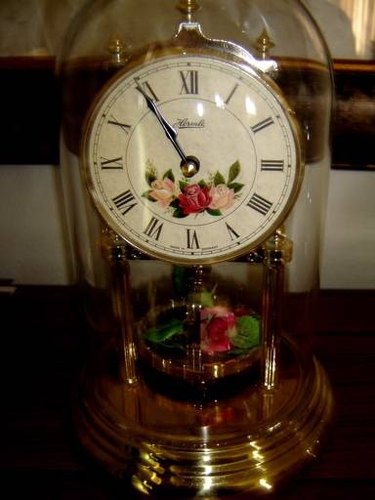
History
Around 1880, a German clock maker, Anton Harder, patented a torsion suspension clock that worked for a year with just one winding. These "anniversary clocks" were also called "400-day clocks" and "1,000-day clocks" to indicate winding frequency.
Anniversary clocks became popular gifts for birthdays and anniversaries. These ornamental clocks with glass domes and openwork mechanisms graced mantels and fascinated onlookers. Their openwork mechanisms literally showcased the passage of time because the pendulum movement was visible.
Video of the Day
Video of the Day
Today battery operation has replaced physical winding, although the basic mechanical principles remain intact. "Anniversary clocks" still stands, because in most cases, the batteries need replacing about once a year. The original anniversary clocks are now mainly family heirlooms and the domain of collectors.
Pendulum

An anniversary clock is a torsion clock. A torsion pendulum operates the clock. After several incarnations, the flat disc pendulum of the earliest anniversary clocks became today's torsion suspension pendulum that twirls while suspended in a hovering position. Usually, three to four small gold, silver or crystal globes on individual spokes decorate the base. Other decorative elements include artificial flowers.
Spring
The pendulum is suspended from a torsion spring. The spring is a rope-like suspension wire. The torsion spring works like the high wire supporting a Cirque de Soleil performer, except that it does not have the same flexibility of movement. It moves only clockwise, then counterclockwise, in a fixed rotation.
Timekeeping
The clock's internal gears energize the torsion spring. It operates on less energy than a conventional pendulum that swings from side to side. Temperature and humidity fluctuations affected the elasticity of the suspension spring in early torsion clocks, making them inaccurate timekeepers. In 1951, Charles Terwilliger invented a suspension spring that overcame the problem.
Level Placement
Place torsion clocks on a level surface. They will not function properly otherwise. Imbalance causes the pendulum to stop twirling. On most torsion clocks, there are three strategically placed discs at the base. Adjust them as needed to keep the clock level.